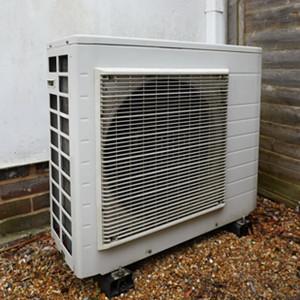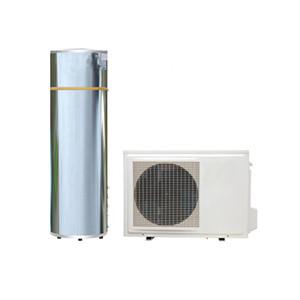Air Source Heat Pump Power Consumption
The operation of the heat pump is based on the refrigeration cycle process, in which heat from the exhaust environment is raised to the required temperature level. This requires the use of a scroll or piston compressor. They work efficiently and are almost silent, but often consume electricity. The following sections describe the heating power consumption of a heat pump, the factors on which it depends and how it is calculated.
Various factors affect heat pump power consumption
Depending on the heat source, heat pumps require approximately 20 to 25 percent of electricity as driving energy to generate heat from air, soil, or water. This means that to produce ten kilowatt hours of usable heat, approximately two kilowatt hours (kWh) of electricity are required. The annual consumption of a heat pump depends on various influencing factors. The most important of them are:
1. Heat pump type
2. Seasonal performance factors
3. Heat demand
1. Heat pump type affects power consumption
The heat source that a heat pump heating system can utilize will affect the electricity costs incurred. Generally speaking: air source heat pumps have higher power consumption than brine/water or water/water heat pumps. This is because the soil and water dissipate heat relatively evenly throughout the year. The ambient temperature fluctuates greatly. More energy is required to meet heat demand, especially in winter. Air source heat pumps, on the other hand, can be installed almost anywhere, require no official approval, and are cheaper to purchase and install. This is because heat recovery does not require drilling or excavation.
2. Seasonal performance factors as efficiency characteristic values
A Seasonal Performance Factor (SPF) is required to roughly calculate the power consumption of a heat pump. This sets the relationship between the heat energy produced and the electrical energy used. For example, with a seasonal performance factor of 4, a heat pump can produce 4 kWh of heat energy using 1 kWh of electricity. Therefore, the higher the SPF, the more efficient and energy-saving the heat pump is.
Please note: The calculated seasonal performance factors are theoretical values. The calculation is based on standard values such as room temperature, domestic hot water consumption, climate zone and ventilation practices. In practice, SPF may deviate from the theoretically determined value.
In addition to the seasonal coefficient of performance, heat pumps can also be assigned a coefficient of performance (COP). This also represents the ratio of energy supplied to energy dissipated. However, COP is only valid at a specific point in time, such as when the air temperature is 15 degrees Celsius and the water flow temperature is 35 degrees Celsius. This means it's just a snapshot.
3. Heat demand plays an important role
In addition to seasonal performance factors and heat sources, individual heat requirements are the decisive factor in heat pump power consumption. The level of heat demand depends on the individual user behavior of the occupants and the energy profile of the building. For example, older buildings that have not been modernized have higher thermal demands than new buildings that are well insulated. Last but not least, there is a difference whether a heat pump is used only to generate space heating or is also used to heat domestic hot water. Therefore, it is impossible to make blanket statements.

Calculate heat pump power consumption
Three variables are needed to roughly determine a heat pump's power consumption: heating output, seasonal performance coefficient, and operating or heating time. Use the following formula to calculate:
Heat pump power consumption = heating capacity/SPF x operating hours
Example calculation: If a 10 kW brine/water heat pump with SPF 4.0 is run for 2000 hours per year, it will require 5000 kWh (10 / 4.0 x 2000 = 5000 kWh).
If a system owner wants to calculate their annual electricity bill, they can multiply the total by the kilowatt price:
Heat pump electricity bill = electricity consumption × cost per kilowatt hour
Heat pump electricity could cut costs
Although the special electricity price does not reduce the heating energy consumption of the heat pump, it can still save costs. This is because with heat pump electricity the supplier has the right to temporarily interrupt the supply during peak load periods. This allows for better load management. In return, heat pump electricity is cheaper. However, in order to benefit from these electricity prices, separate electricity meters must be installed so that household and heat pump electricity can be billed separately.
Heat pump electricity is indistinguishable from conventional electricity in terms of characteristics and quality. For system owners, only two factors matter - cost and source. Many suppliers now offer heat pump electricity. Some of these countries also have green electricity prices within their range. It is recommended to compare tariffs before signing a contract. Once the system owner has found the heat pump rate that works best for them, they can change the rate normally, taking into account the standard notice period. The process is handled exactly like traditional electricity.
What does blocking time mean for a heat pump?
If the electric utility company (EVU) disconnects the system from the grid, this is called the heat pump's blocking time or outage. The electric heat pump heating system will not be operational during this period. However, the buffer cylinder can ensure the supply of heat energy and domestic hot water. System operators should take this into account in planning. Since the heat pump not only heats but also charges the storage unit during this period, a higher output is required. This addition can be calculated using the blocking time factor.
Blocking time coefficient = 24 hours/(24 hours - total blocking time during the day)
Calculation example: If the electricity supply company interrupts the power supply to the heat pump heating 3 times for 2 hours each time, the output must be one third higher (24 / 24 - 6 = 1.3).
The number and duration of interruptions are regulated by law. A maximum of three blocking periods of 2 hours each are allowed per day.
There are various ways to influence the energy consumption of a heat pump
A large proportion of the energy required by a household is used for room heating and domestic hot water. By replacing an outdated central heating boiler with a heat pump or hybrid system, homeowners can reduce energy needs by up to 30%. They can be more successful if, in addition to modernizing their heating system, they take further steps, such as hydronic balancing or replacing the thermostat. However, to minimize energy consumption, radiators should also be matched to the heating system. Efficient heat pump consumption is best achieved in combination with a panel heating system.
Can I operate a heat pump using underfloor heating only?
An underfloor heating system is a zone heating system that transfers heat into a room through radiant heat. In this way, the thermal energy is evenly distributed over a large area and its effect is only released when it hits a solid object such as a wall or person. Due to its large surface area, underfloor heating can cope with water flow temperatures of around 35 degrees Celsius.
In comparison, radiators require temperatures as high as 70 degrees Celsius. Since the efficiency of a heat pump heating system increases further the smaller the difference between the heat source and the flow temperature of the heating system, underfloor heating operation is not only possible, but also recommended. This is because this combination is where the heat pump achieves its greatest possible efficiency. Heat pumps operating in dual mode or hybrid heat pumps are recommended for warmer radiator systems and older buildings. You can find more relevant information in the sections about heat pumps and heat pumps in new and old buildings.
Meet your own heat pump power needs
The consumption of heat pumps can also be met cheaply through solar power generation on one's own roof. Photovoltaic systems harness free solar energy to generate electricity. The storage unit ensures that you can use this energy even when the sun is not available. Therefore, the consumption of self-generated electricity makes the electricity supply more independent.
Get more help
Leomon is a heat pump manufacturer from China. If you are considering purchasing an air source heat pump. Please contact us and our heat pump experts will give you the best advice.





